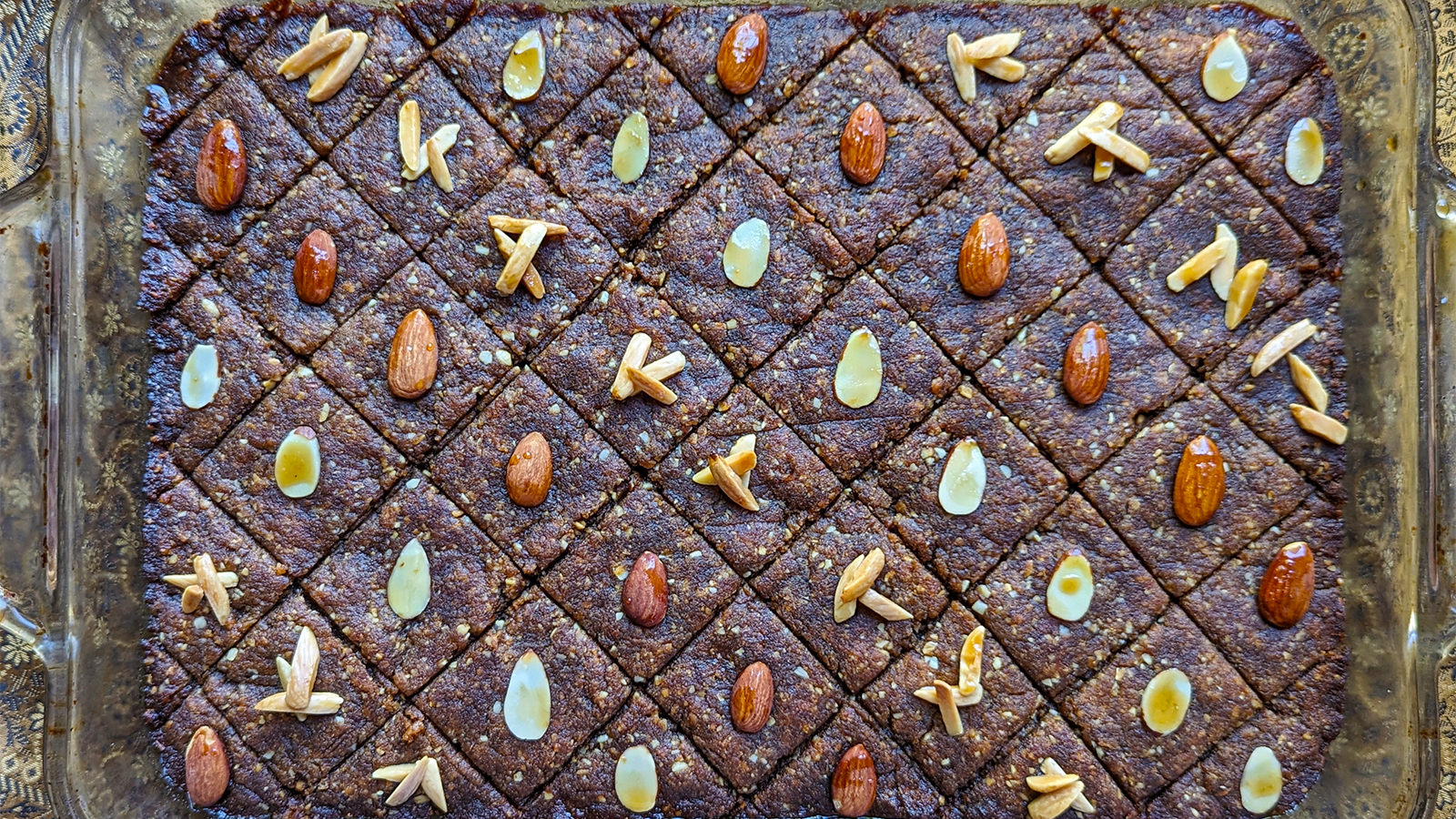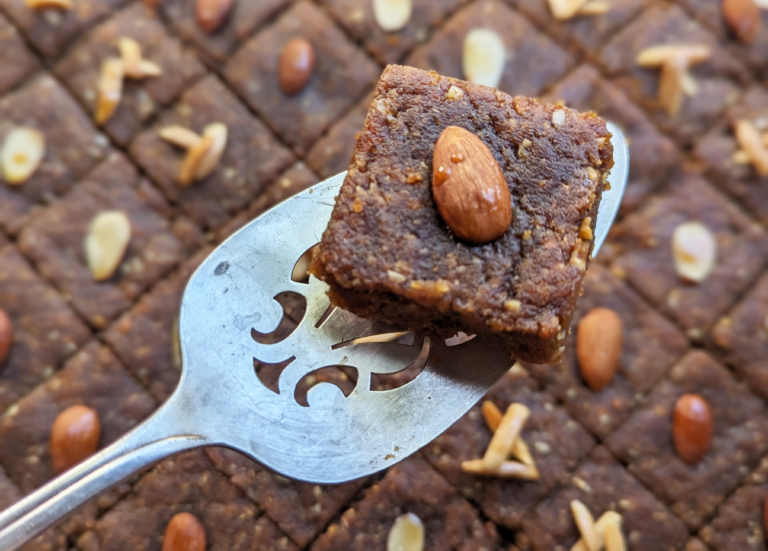Honey cake is a hallmark of Rosh Hashanah and the fall Jewish holidays — Ashkenazi honey cake, that is. But did you know there’s a Sephardi cake traditionally served for Rosh Hashanah, Yom Kippur break fast and during Sukkot? Like its Eastern European counterpart, tishpishti symbolizes wishes for a sweet new year and the fullness of life. The cake is also popular for Purim and adapted for Passover.
Semolina pastries and puddings have been made for centuries throughout the Mediterranean, North Africa and the Middle East. Tishpishti is traditionally made with fine semolina and soaked in a sweet syrup of sugar, honey or a mixture, but beyond these common elements, there are many variations in both the way tishpishti is made — such as nuts or no nuts, eggs or no eggs, flavored with lemon, orange or rose water — and even what it’s called according to different geographic and cultural roots. For example, in Egypt, it’s basboosah or baboussa, namora or namoura in Syria and shamali in Crete.
Tishpishti is perhaps the name most used and, as we know it today, the cake originated in Turkey. In the “Encyclopedia of Jewish Food,” Gil Marks explains that in Israel and for Jews from once-Ottoman Turkey, Greece and the Balkans, the name is probably a nonsense name from the Turkish “tez” (fast/quick) and “pişti” (plane/slope). Put together, it means “quickly done.” In Ladino it might also be called pispiti, tupishti and revani, which Joyce Goldstein in “Sephardic Flavors: Jewish Cooking of the Mediterranean” notes is named after a 16th century Turkish poet “who wrote about the delights of food.”
Many tishpishti recipes use eggs, including ones that instruct you to whip the whites separate from the yolks, a Sephardi contribution to tishpishti. This recipe, however, is based on a very old traditional way of making cakes from a thick dough without eggs. My concession to modernity is adding baking powder and soda, both 19th century products, to lessen the density of the cake. Using ground almonds instead of walnuts will result in a lighter colored cake, which is traditional at Rosh Hashanah to symbolize a bright new year. Tishpishti is delicious on its own or served with a spoonful of yogurt, labneh or whipped cream and a cup of mint tea or strong Turkish coffee.
The Nosher celebrates the traditions and recipes that have brought Jews together for centuries. Donate today to keep The Nosher's stories and recipes accessible to all.
Notes:
- It is best to make the syrup ahead of time so it has time to cool, although you can choose to make it while the cake bakes, then refrigerate it to cool more quickly.
- Tishpishti is best when left at room temperature for several hours or overnight so the syrup penetrates the cake.
- Store wrapped at room temperature for two days or a week in the refrigerator. The cake can be well-wrapped and frozen for two months. Defrost and then refresh with some drizzles of warm syrup.
Tishpishti Recipe
This syrup-soaked semolina cake is steeped in history.
- Total Time: 1 hour 15 minutes
- Yield: about 26-30 diamond-shaped pieces
Ingredients
For the syrup:
- ¾ cup sugar
- ¾ cup honey
- ¾ cup water
- 1–2 Tbsp fresh lemon juice or orange blossom water
For the cake:
- 1 cup fine semolina (not semolina flour)
- 2 cups all-purpose or one-to-one gluten-free flour or almond flour
- 1½ cups finely ground walnut or almond meal (not flour)
- 1 tsp baking powder
- 1 tsp baking soda
- 1 tsp cinnamon
- 1 cup good neutral vegetable oil (such as avocado, sunflower or peanut)
- 2 cups water
- ½ cup honey
- ½ cup sugar
- 2 tsp finely grated lemon or orange zest or a combination
- ⅛ tsp salt
- about 30 slices blanched almonds, whole almonds or walnuts, or chopped almonds or walnuts
Instructions
- To make the syrup, begin by stirring the sugar, honey, water and lemon juice (if using) together in a heavy saucepan over medium heat until the sugar dissolves, about 5 minutes. Stop stirring, turn the heat up to medium-high until the mixture begins to boil, then reduce heat to a gentle boil. Cook about 15 minutes until the mixture thickens, but is still syrupy. Remove from the heat and if using orange blossom water, stir it in now. Let the syrup cool to room temperature while the cake bakes.
- To make the cake, preheat oven to 350°F. Lightly grease a 9×13-inch pan.
- In a large bowl, whisk together the semolina, flour, nuts, baking powder, baking soda and cinnamon until well blended. Set aside.
- In a large saucepan, mix the oil, water, honey, sugar, cinnamon, zest and salt. Heat over medium, stirring often. Remove the saucepan from the heat just as it begins to boil. Using a wooden spoon, stir in the flour mixture, about ⅓ at a time, until it is totally absorbed and the batter is well blended. It might seem like the last bit can’t get mixed in, but it will in the end. The resulting batter will be thick and dough-like.
- Scoop the mixture into the greased pan and gently pat to flatten the batter with your hands so it is spread evenly and the edges are straight and even. (An offset spatula can be used to help to smooth the surface evenly and make sharp, clean edges.) Score the cake into small diamond shapes, about 26-30 pieces 1½ inches wide, cutting about half way down. Gently press one almond slice or whole nut on top of each piece in the center. Bake for 40-45 minutes until the edges are just starting to brown.
- Take the cake out of the oven, then immediately pour about half the room-temperature syrup slowly and evenly over the hot cake, which will absorb the syrup as it cools. Wait a few minutes, then follow the scoring to cut all the way through the pieces. Pour the rest of the syrup evenly into the cuts and over the whole cake. Tishpishti is best when left at room temperature for several hours or overnight so the syrup penetrates the cake.
Notes
- It is best to make the syrup ahead of time so it has time to cool, although you can choose to make it while the cake bakes, then refrigerate it to cool more quickly.
- Tishpishti is best when left at room temperature for several hours or overnight so the syrup penetrates the cake.
- Store wrapped at room temperature for two days or a week in the refrigerator. The cake can be well-wrapped and frozen for two months. Defrost and then refresh with some drizzles of warm syrup.
- Prep Time: 30 minutes
- Cook Time: 45 minutes
- Category: Dessert
- Method: Baking
- Cuisine: Sephardic





B’h i have just enuf semolina. Can i use butter?
What is the difference between semolina and semolina flour?
Pisti (Pishti) means baked/cooked in Turkish .. so TizPishti would be quickly baked. A version of this is prepared for Passover (with proper ingredients)
Rema (Orach Chaim 583:2) writes that some are careful not to eat egozim (walnuts) on Rosh Hashanah. This is because the gematria (numerical value) of the Hebrew word “egoz” is the same as the numerical value for the word chait (sin). Additionally, nuts cause an increase in phlegm, which can disturb one’s prayers.
Hi! Any ideas for substituting the ground walnuts/almonds for a tree nut free version? Unfortunately we have tree nut allergies in our household 🙁
I would suggest making a different dessert if you need to avoid nuts.
can this be made without any type of nuts ? or will it change the cake to much ??
I would suggest making a different dessert if you need to avoid nuts.
The syrup instructions list “1-2 Tbsp fresh lemon juice or orange blossom water”.
QUESTION – Which is better to use, lemon juice or orange blossom water?
Then, the instructions say to make the syrup, “stir the honey, water, and lemon or orange juice”. Then says “if using orange blossom water, stir it in now”.
QUESTIONS: Is the orange blossom water IN ADDITION TO the lemon juice? Is OJ used instead of lemon juice? How much of each?
I can’t find semolina. What should I substitute??
Hi Rhona, I recommend looking for semolina on Amazon or at Middle Eastern stores.
Looks great 👍 and thanks 😊 for sharing 😀 👍 😊 THANKS AGAIN
It has no eggs?
No! And happily eaten by my egg allergic grandson. Enjoy!
I made the cake and froze it. After it was defrosted and room temperature I put another batch of syrup on but it only partly absorbed. I think it would have been better to warm it a bit in the oven before putting the syrup so it wouldn’t be so wet. But my husband says it tastes fine.
I can’t wait to make this!
Is Cream of Wheat a good substitute for the semolina?
They tend not to be interchangeable in recipes, sorry about that.